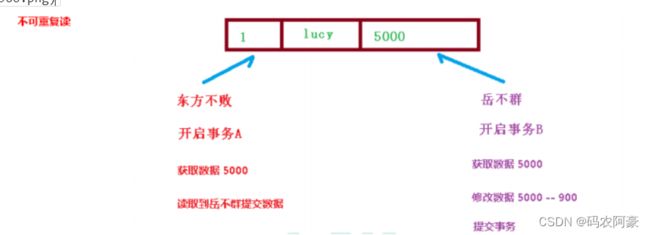Spring5系列学习文章分享---第五篇(事务概念+特性+案例+注解声明式事务管理+参数详解 )
目录
-
- 事务
-
- 事务概念
-
- 什么是事务
- 事务四个特性(ACID)
- 搭建事务操作环境
- Spring 事务管理介绍
- 注解声明式事务管理
- 声明式事务管理参数配置
- XML 声明式事务管理
- 事务操作(完全注解声明式事务管理)
- 感谢阅读
开篇:
欢迎再次来到 Spring 5 学习系列!在这个博客中,我们将深入研究 Spring 框架的J事务概念+特性+案例+注解声明式事务管理+参数详解
事务
事务概念
什么是事务
(1)事务是数据库操作最基本单元,逻辑上一组操作,要么都成功,如果有一个失败所有操
作都失败
(2)典型场景:银行转账
* lucy 转账 100 元 给 mary
* lucy 少 100,mary 多 100
事务四个特性(ACID)
(1)原子性
(2)一致性
(3)隔离性
(4)持久性
搭建事务操作环境
- 创建数据库表,添加记录
| id | username | money |
|---|---|---|
| 1 | lucy | 1000 |
| 2 | mary | 1000 |
- 创建 service,搭建 dao,完成对象创建和注入关系
- service 注入 dao,在 dao 注入 JdbcTemplate,在 JdbcTemplate 注入 DataSource
@Service
public class UserService {
//注入 dao
@Autowired
private UserDao userDao;
}
@Repository
public class UserDaoImpl implements UserDao {
@Autowired
private JdbcTemplate jdbcTemplate;
}
- 在 dao 创建两个方法:多钱和少钱的方法,在 service 创建方法(转账的方法)
@Repository
public class UserDaoImpl implements UserDao {
@Autowired
private JdbcTemplate jdbcTemplate;
//lucy 转账 100 给 mary
//少钱
@Override
public void reduceMoney() {
String sql = "update t_account set money=money-? where username=?";
jdbcTemplate.update(sql,100,"lucy");
}
//多钱
@Override
public void addMoney() {
String sql = "update t_account set money=money+? where username=?";
jdbcTemplate.update(sql,100,"mary");
}
}
@Service
public class UserService {
//注入 dao
@Autowired
private UserDao userDao;
//转账的方法
public void accountMoney() {
//lucy 少 100
userDao.reduceMoney();
//mary 多 100
userDao.addMoney();
}
}
- 上面代码,如果正常执行没有问题的,但是如果代码执行过程中出现异常,就会有问题
@Service
public class UserService {
//注入 dao
@Autowired
private UserDao userDao;
//转账的方法
public void accountMoney() {
//lucy 少 100
userDao.reduceMoney();
// 模拟by zero异常
int i = 1/0;
//mary 多 100
userDao.addMoney();
}
}
-
上面问题如何解决呢?
- 使用事务来解决
-
事务操作过程
//转账的方法
public void accountMoney() {
try{
// **第一步** 开启事务
// **第二步** 进行事务操作
//lucy 少 100
userDao.reduceMoney();
// 模拟by zero异常
int i = 1/0;
//mary 多 100
userDao.addMoney();
// **第三步** 没有发生异常,提交事务
}catch(Exception e){
// **第四步** 出现异常,事务回滚
}
}
Spring 事务管理介绍
-
事务添加到 JavaEE 三层结构里面 Service 层(业务逻辑层)
-
在 Spring进行事务管理操作
- 有两种方式:编程式事务管理和声明式事务管理(使用)
- 声明式事务管理
-
基于注解方式(使用)
-
基于 xml 配置文件方式
-
在Spring 进行声明式事务管理,底层使用 AOP 原理
-
Spring 事务管理 API
注解声明式事务管理
- 在 spring 配置文件配置事务管理器
<bean id="transactionManager"
class="org.springframework.jdbc.datasource.DataSourceTransactionManager">
<property name="dataSource" ref="dataSource">property>
bean>
- 在 spring 配置文件,开启事务注解
- 在 spring 配置文件引入名称空间 tx
<beans xmlns="http://www.springframework.org/schema/beans"
xmlns:xsi="http://www.w3.org/2001/XMLSchema-instance"
xmlns:context="http://www.springframework.org/schema/context"
xmlns:aop="http://www.springframework.org/schema/aop"
xmlns:tx="http://www.springframework.org/schema/tx"
xsi:schemaLocation="http://www.springframework.org/schema/beans
http://www.springframework.org/schema/beans/spring-beans.xsd
http://www.springframework.org/schema/context
http://www.springframework.org/schema/context/spring-context.xsd
http://www.springframework.org/schema/aop
http://www.springframework.org/schema/aop/spring-aop.xsd
http://www.springframework.org/schema/tx
http://www.springframework.org/schema/tx/spring-tx.xsd">
- 开启事务注解
<tx:annotation-driven transaction-manager="transactionManager">tx:annotation-driven>
- 在 service 类上面(或者 service 类里面方法上面)添加事务注解
(1)@Transactional,这个注解添加到类上面,也可以添加方法上面
(2)如果把这个注解添加类上面,这个类里面所有的方法都添加事务
(3)如果把这个注解添加方法上面,为这个方法添加事务
@Service
@Transactional
public class UserService {}
声明式事务管理参数配置
- 在 service 类上面添加注解@Transactional,在这个注解里面可以配置事务相关参数
- propagation**:事务传播行为**
- ioslation:事务隔离级别
(1)事务有特性成为隔离性,多事务操作之间不会产生影响。不考虑隔离性产生很多问题
(2)有三个读问题:脏读、不可重复读、虚(幻)读
(5)虚读:一个未提交事务读取到另一提交事务添加数据
(6)解决:通过设置事务隔离级别,解决读问题
- timeout:超时时间
(1)事务需要在一定时间内进行提交,如果不提交进行回滚
(2)默认值是 -1 ,设置时间以秒单位进行计算
- readOnly:是否只读
(1)读:查询操作,写:添加修改删除操作
(2)readOnly 默认值 false,表示可以查询,可以添加修改删除操作
(3)设置 readOnly 值是 true,设置成 true 之后,只能查询
-
rollbackFor:回滚
-
noRollbackFor:不回滚
- 设置出现哪些异常不进行事务回滚
XML 声明式事务管理
- 在 spring 配置文件中进行配置
第一步 配置事务管理器
第二步 配置通知
第三步 配置切入点和切面
<bean id="transactionManager"
class="org.springframework.jdbc.datasource.DataSourceTransactionManager">
<property name="dataSource" ref="dataSource">property>
bean>
<tx:advice id="txadvice">
<tx:attributes>
<tx:method name="accountMoney" propagation="REQUIRED"/>
tx:attributes>
tx:advice>
<aop:config>
<aop:pointcut id="pt" expression="execution(*
com.atguigu.spring5.service.UserService.*(..))"/>
<aop:advisor advice-ref="txadvice" pointcut-ref="pt"/>
aop:config>
事务操作(完全注解声明式事务管理)
1、创建配置类,使用配置类替代 xml 配置文件
@Configuration //配置类
@ComponentScan(basePackages = "com.atguigu") //组件扫描
@EnableTransactionManagement //开启事务
public class TxConfig {
//创建数据库连接池
@Bean
public DruidDataSource getDruidDataSource() {
DruidDataSource dataSource = new DruidDataSource();
dataSource.setDriverClassName("com.mysql.jdbc.Driver");
dataSource.setUrl("jdbc:mysql:///user_db");
dataSource.setUsername("root");
dataSource.setPassword("root");
return dataSource;
}
//创建 JdbcTemplate 对象
@Bean
public JdbcTemplate getJdbcTemplate(DataSource dataSource) {
//到 ioc 容器中根据类型找到 dataSource
JdbcTemplate jdbcTemplate = new JdbcTemplate();
//注入 dataSource
jdbcTemplate.setDataSource(dataSource);
return jdbcTemplate;
}
//创建事务管理器
@Bean
public DataSourceTransactionManager
getDataSourceTransactionManager(DataSource dataSource) {
DataSourceTransactionManager transactionManager = new
DataSourceTransactionManager();
transactionManager.setDataSource(dataSource);
return transactionManager;
}
}
感谢阅读
感谢您阅读 Spring 5 学习系列的第五篇!在这篇文章中,我们探索了Spring5的(事务概念+特性+案例+注解声明式事务管理+参数详解 )
下一篇文章即将发布! 在第六篇中,我们将深入研究Spring 5的新特性,为您分享我学习的Spring5的收获,请继续关注我的系列。
谢谢您的陪伴! 如果您有任何问题、建议或想要了解的特定主题,请随时在评论中告诉我们。我们期待与您共同探索Spring 5,共同提升我们的Java开发技能!
敬请期待第六篇的发布,我们将很快与您再次见面!
学习视频来源尚硅谷Spring5







